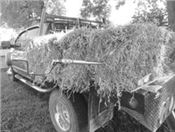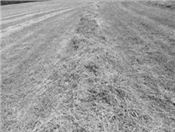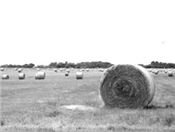|
Marketing Hay 101: No Official Grader Of Hay; Important To Get Hay Analyzed By Reputable Laboratory
MT. VERNON, MO.
There are no official graders of hay in Missouri according to Eldon Cole, field specialist in livestock with University of Missouri Extension.
“One of the most useful ways of grading hay is to have it analyzed by a reputable laboratory for the basics such as moisture, protein, acid detergent fiber and neutral detergent fiber,” said Cole.
From these tests, an estimate of energy or total digestible nutrients (TDN) will be made.
“For the hay show at the Ozark Empire Fair, we request the lab to calculate a Relative Forage Quality (RFQ) and a Relative Feeding Value (RFV). These numbers are not used in ration development, but help make a quality comparison for marketing or hay contests,” said Cole.
Some states even quote alfalfa prices based on the RFV at $1.00 to $1.10 per RFV point. An alfalfa that scores an RFV of 185 would be priced at $185 per ton. The value per point is lower on grass hays and typically I hear $.75 to .85 cents per point of RFV.
The RFV is being replaced by RFQ in our hay shows as research shows it to be a better predictor of dry matter intake and digestible energy.
Missouri Department of Agriculture does report names of hay grades along with the RFV. Those ranges for alfalfa are: greater than 185 RFV is Supreme; 170 to 185 RFV is Premium; 150 to 170 is Good; Fairy quality is 130 to 150 RFV.
“Not everyone has their hay tested by a certified lab, such as the Custom Lab at Monett which we use for the Ozark Empire Fair. But without the objective test we resort to a subjective description of the hay when harvested,” said Cole.
Some of those subjective descriptions are: supreme alfalfa is pre-bloom, soft, fine stems, extra leafy, excellent color and free of damage; premium pre-bloom in legumes and pre-head in grasses, extra leafy and fine stems, green and free of damage.
Technically speaking, Cole says that good quality is early to average maturity, early to mid-bloom in legumes and early head in grasses and it is fine to medium stemmed, free of damage other than slight discoloration. Fair quality denotes late maturity, mid to late bloom in legumes, also fully headed in grasses, moderate or below leaf count, coarse stemmed, and it may show slight damage, while utility indicates very late maturity, seedpods forming, heavy weed content and moldy.
Unlike some commodities, hay grades are not standardized.
“You can search hay for sale on several websites and this year find many, places to buy hay, The sites we looked at were pretty vague in their description of the hay other than bale dimensions. Few mentioned actual bale weight and only one said the hay was tested. It did not specify whether it "passed the test" or not,” said Cole.
MU Extension specialists urge producers to wisely shop when buying forage. Hay or haylage tests, along with actual bale weights, should always be considered. ∆

Don't guess, use a hay probe and test the hay for quality.
Photo credit: MU Extension

Windrow of alfalfa ready to be baled.

There is an abundance of hay available in 2019, but quality varies.
|
|